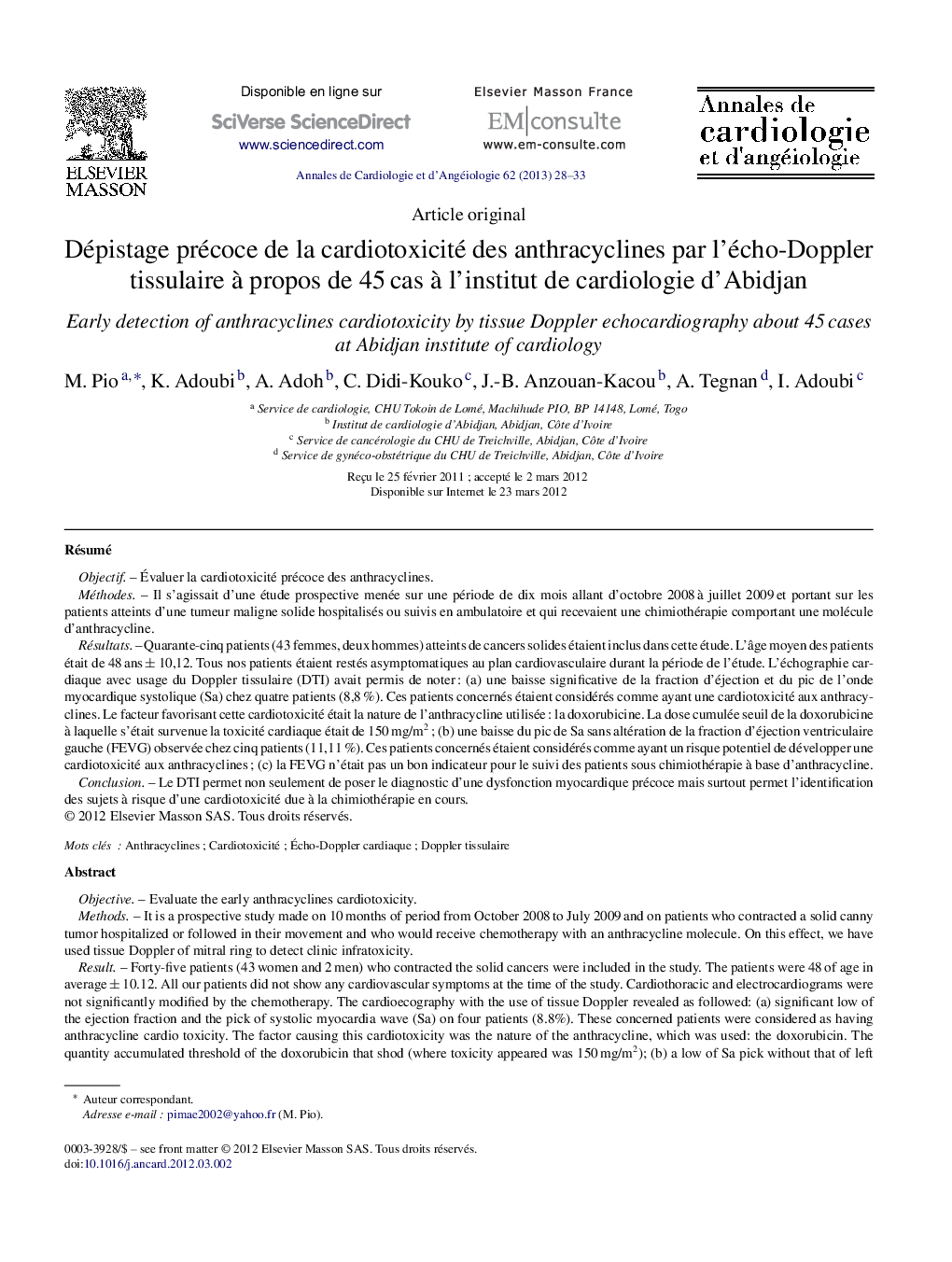| Article ID | Journal | Published Year | Pages | File Type |
|---|---|---|---|---|
| 2869008 | Annales de Cardiologie et d'Angéiologie | 2013 | 6 Pages |
RésuméObjectifÉvaluer la cardiotoxicité précoce des anthracyclines.MéthodesIl s’agissait d’une étude prospective menée sur une période de dix mois allant d’octobre 2008 à juillet 2009 et portant sur les patients atteints d’une tumeur maligne solide hospitalisés ou suivis en ambulatoire et qui recevaient une chimiothérapie comportant une molécule d’anthracycline.RésultatsQuarante-cinq patients (43 femmes, deux hommes) atteints de cancers solides étaient inclus dans cette étude. L’âge moyen des patients était de 48 ans ± 10,12. Tous nos patients étaient restés asymptomatiques au plan cardiovasculaire durant la période de l’étude. L’échographie cardiaque avec usage du Doppler tissulaire (DTI) avait permis de noter : (a) une baisse significative de la fraction d’éjection et du pic de l’onde myocardique systolique (Sa) chez quatre patients (8,8 %). Ces patients concernés étaient considérés comme ayant une cardiotoxicité aux anthracyclines. Le facteur favorisant cette cardiotoxicité était la nature de l’anthracycline utilisée : la doxorubicine. La dose cumulée seuil de la doxorubicine à laquelle s’était survenue la toxicité cardiaque était de 150 mg/m2 ; (b) une baisse du pic de Sa sans altération de la fraction d’éjection ventriculaire gauche (FEVG) observée chez cinq patients (11,11 %). Ces patients concernés étaient considérés comme ayant un risque potentiel de développer une cardiotoxicité aux anthracyclines ; (c) la FEVG n’était pas un bon indicateur pour le suivi des patients sous chimiothérapie à base d’anthracycline.ConclusionLe DTI permet non seulement de poser le diagnostic d’une dysfonction myocardique précoce mais surtout permet l’identification des sujets à risque d’une cardiotoxicité due à la chimiothérapie en cours.
ObjectiveEvaluate the early anthracyclines cardiotoxicity.MethodsIt is a prospective study made on 10 months of period from October 2008 to July 2009 and on patients who contracted a solid canny tumor hospitalized or followed in their movement and who would receive chemotherapy with an anthracycline molecule. On this effect, we have used tissue Doppler of mitral ring to detect clinic infratoxicity.ResultForty-five patients (43 women and 2 men) who contracted the solid cancers were included in the study. The patients were 48 of age in average ± 10.12. All our patients did not show any cardiovascular symptoms at the time of the study. Cardiothoracic and electrocardiograms were not significantly modified by the chemotherapy. The cardioecography with the use of tissue Doppler revealed as followed: (a) significant low of the ejection fraction and the pick of systolic myocardia wave (Sa) on four patients (8.8%). These concerned patients were considered as having anthracycline cardio toxicity. The factor causing this cardiotoxicity was the nature of the anthracycline, which was used: the doxorubicin. The quantity accumulated threshold of the doxorubicin that shod (where toxicity appeared was 150 mg/m2); (b) a low of Sa pick without that of left ventricular fraction ejection observed on five patients (11.11%). These concerned patients were considered as having potential risks to develop anthracyclines cardiotoxicity; (c) the left ventricular ejection fraction was not a good indicator the check up of the patients under chemotherapy made up with anthracyclines.ConclusionThe tissue Doppler not only enables to make diagnostics of early myocardia dysfunctions but it mainly allows to identify people with risks of a cardiotoxicity due to a going on chemotherapy.
